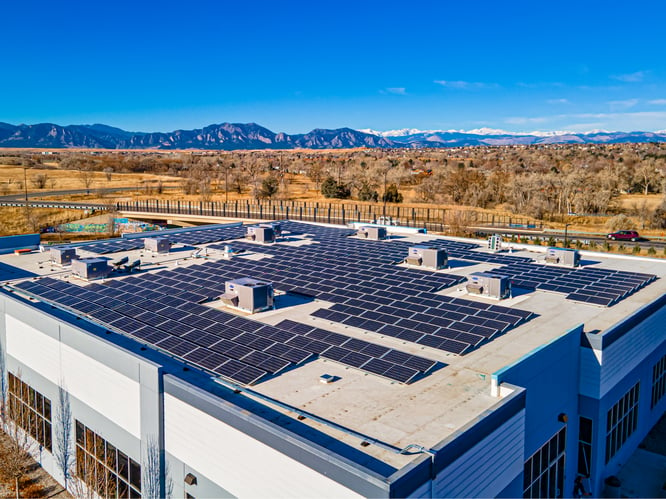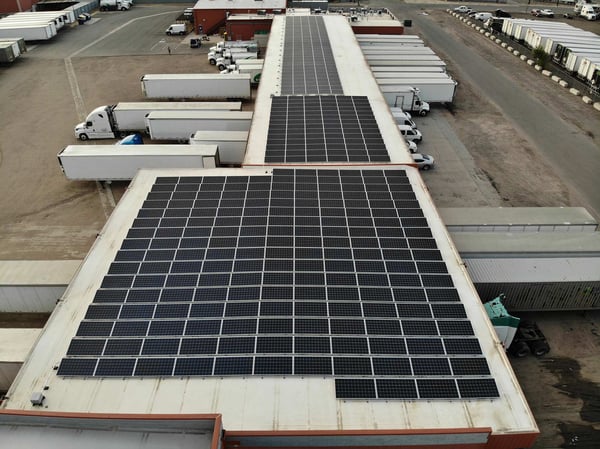Blog Updated: August 2024
For commercial property owners with triple net leases, recouping the costs of a capital energy improvement can be a barrier to making sustainable investments. Typically, these improvements lower the tenants’ utility bills in triple net leases, so the owner is not financially incentivized to invest in those improvements. This is known as the “split incentive.”
There are two ways to overcome the split incentive with solar as well as four financial incentives that benefit commercial property owners directly. These solutions provide financial motivation for both owners and tenants to carry out capital energy improvement projects that may have otherwise been overlooked.
Why are Capital Energy Improvements Important?
Tenant demand, municipal requirements, and a desire for differentiation in the market are all driving investments in building efficiency. For cities, addressing the carbon impact of commercial properties is a necessity for meeting increasingly aggressive climate goals.
Fortunately, market-research shows that green buildings are good for business. Tenants are choosing energy-efficient buildings because they reduce operating expenses (OpEx), attract employees and customers, and offer marketing benefits. Owners also benefit from these improvements because they increase property value, differentiate the property, and attract quality tenants who stay longer and pay more.
Can I Benefit from Solar on my Triple Net Lease Properties?
Yes. Ownership groups can earn an attractive return by investing in onsite solar for their commercial properties. There are four direct financial benefits to a commercial solar investment. Roughly half of the original investment comes back via two tax benefits that can be monetized in the first year of operation: 30% base Federal Investment Tax Credit (ITC) plus possible tax credit adders under the Inflation Reduction Act and bonus depreciation). Plus, solar production can generate incentive income from the utility, as well as provide OpEx reduction which is a good segue into the next section on overcoming the split incentive.
 BH 305 Arthur LLC partnered with Namaste Solar for a 127 kW commercial solar installation on the rooftop of the Louisville office building. This is a NNN lease where the owner of the building uses a lease agreement to recoup some of the savings from the tenant.
BH 305 Arthur LLC partnered with Namaste Solar for a 127 kW commercial solar installation on the rooftop of the Louisville office building. This is a NNN lease where the owner of the building uses a lease agreement to recoup some of the savings from the tenant.
What is the Solution to the Split Incentive?
Fortunately, there are two common strategies that bring value from reduced utility bills to both tenants and owners: Commercial Property Assessed Clean Energy financing (C-PACE) and “green lease” language.
C-PACE covers up to 100% of project costs at fixed interest rates with terms up to 25 years. This non-recourse financing is secured by the property and repaid via a special assessment on property taxes and is therefore transferable upon sale.
In a C-PACE-financed commercial solar investment, the building owner realizes the tax benefits, as well as utility incentive income. The triple net lease tenant is responsible for C-PACE payments since property taxes are usually passed through. However, their OpEx reduction from solar will often exceed those payments, generating positive cash flow for both the owner and tenant.
The second solution, green leases, lays a foundation for the owner to recoup a portion of the utility savings from solar, in addition to the tax benefits and incentive income. Similar to existing cost-recovery clauses, green lease language details a path for landlords to be compensated for the utility savings that their asset provides to the tenant. A New York City-commissioned report suggests that tenants pay owners at least 80% of modeled savings.
These two solutions provide financial motivation for both owners and tenants to implement capital energy improvement projects, like commercial solar installations, that were historically overlooked. Combined with our collective need to reduce the carbon emissions of our commercial building stock, these opportunities make now the perfect time for commercial property owners to take action.

Namaste Solar worked with Glenwood Properties, a real estate company, to overcome the issue of split incentive with solar and install a rooftop system on one of their Denver buildings.
A Look at the Numbers
An average 30,000 square foot roof will fit a 200-kilowatt (kW) solar system. A C-PACE deal structured at 50% loan-to-cost for a 25-year term allows the building owner to recoup their entire investment plus an additional $32,000 by the end of year one and increases NOI by an average of $11,000 per year through utility incentive income. The triple net lease tenant is responsible for annual C-PACE payments totaling $18,000 but realizes average annual utility savings of $19,000.
Choosing the Right Partner
An experienced commercial solar developer will work closely with your team to identify your unique goals and design an efficient system that meets your needs. In 2020, Namaste Solar contracted with Glenwood Properties to design and install a 99.9 kW solar array. Our team worked with the owner and triple net lease tenants to find an avenue that would benefit both parties financially while also meeting green energy goals.
Our solar developers can help you navigate C-PACE financing and advise on green lease language which will ensure you earn a compelling return on investment for your project. For more information, explore our project portfolio of completed commercial systems and/or contact one of our non-commissioned solar developers.



